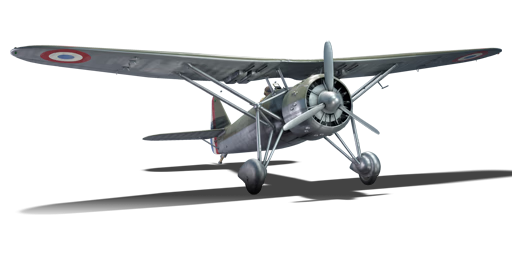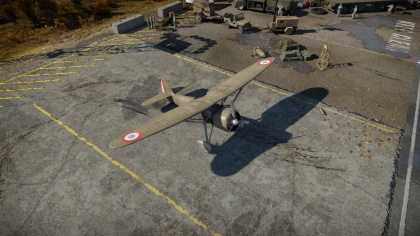D.371
Contents
| This page is about the French reserve fighter D.371. For other uses, see D.37 (family). |
Description
The D.371 is a rank I French fighter
with a battle rating of 1.0 (AB/RB/SB). It was introduced in Update 1.73 "Vive la France".
In the early 1930s, SAF-Avions Dewoitine, a French aircraft manufacturing company developed the D.37 aircraft, a single-seat airplane with a parasol wing, radial engine, fixed landing gear and a tail-skid; however, the actual manufacturing of the aircraft was transferred to Lioré et Olivier. The cockpit did not have an enclosed canopy; just a windshield forward of the pilot.
The D.371 was the first production version of this aircraft line which was first flown in 1934 powered by a Gnome Rhône 14Kfs radial engine and also featured wheel breaks. Four MAC 1934 7.5 mm machine guns were installed, two in each wing and positioned outside of the propeller arch which eliminated the need to synchronize the guns to the propeller spin.
General info
Flight Performance
| Characteristics | |||||||
|---|---|---|---|---|---|---|---|
| Stock | |||||||
| Max Speed (km/h at 3,000 m) |
Max altitude (meters) |
Turn time (seconds) |
Rate of climb (meters/second) |
Take-off run (meters) | |||
| AB | RB | AB | RB | AB | RB | ||
| 374 | 361 | 9000 | 13.9 | 14.4 | 9.7 | 9.7 | 232 |
| Upgraded | |||||||
| Max Speed (km/h at 3,000 m) |
Max altitude (meters) | Turn time (seconds) | Rate of climb (meters/second) |
Take-off run (meters) | |||
| AB | RB | AB | RB | AB | RB | ||
| 412 | 393 | 9000 | 12.7 | 13.0 | 27.4 | 14.2 | 232 |
Details
| Features | ||||
|---|---|---|---|---|
| Combat flap | Take-off flap | Landing flap | Air brakes | Arrestor gear |
| X | X | X | X | X |
| Limits | ||||
|---|---|---|---|---|
| Wing-break speed (km/h) |
Gear limit (km/h) |
Combat flap (km/h) |
Max Static G | |
| + | - | |||
| 560 | 560 | X | ~12 | ~6 |
| Optimal velocities | |||
|---|---|---|---|
| Ailerons (km/h) |
Rudder (km/h) |
Elevators (km/h) |
Radiator (km/h) |
| < 280 | < 360 | < 260 | > 210 |
| Compressor (RB/SB) | ||
|---|---|---|
| Setting 1 | ||
| Optimal altitude | 100% Engine power | WEP Engine power |
| 3,825 m | 880 hp | 1,023 hp |
Survivability and armour
- No armour plating
- No armour glazing
- Open cockpit
- Critical components located at the front of aircraft (fuel, pilot, engine, controls)
Early aircraft did not feature much in the way armored protection as many of the aircraft were at this point were transitioning from wood frame and cloth skin to wood frame and metal skined aircraft. Due to balancing of the aircraft, much of the critical equipment was positioned towards the front of the aircraft, where the engine, fuel tanks, oil pumps, control linkages and the pilot were clustered around each other. With this tight grouping and no armor protection, when fired upon, chances were high to hit a critical component in the aircraft.
Armaments
Offensive armament
Each of the four machine guns is bundled into groups of two and mounted to the underside of the upper wing. Each machine gun is outfitted with the same amount of ammunition, which means that all guns will fire with each other until empty. Due to the mounting locations on the wings (outside of the propeller arc) and the calibre of the machine guns, convergence in this aircraft is important. Most of the fighting with this aircraft will be in close quarters to exploit the power of the machine guns in close. Convergence set between 150 and 300 meters (where ever you are most comfortable) will work best to put the most bullets into the enemy aircraft as possible and hit a critical component. Many pilots in World War I and II would set their weapon's convergence to 200 to 250 meters and would wait until being in that range before firing to ensure best chances for shooting down the enemy. Shots from too far away could "spook" the enemy into evasive maneuvers or just waste ammunition in a "spray and pray" maneuver. Practice and skill will allow the pilot to close within 250 m of the enemy and take them out with controlled bursts and then move onto the next victim.
Usage in the battles
Maintaining speed with this aircraft is a must as a slow D.371 is an easy target. Initial spawning into a map should lead a D.371 pilot to climb and gain altitude. Having an altitude advantage will set you up in a position of power over most other pilots upon reaching the combat area as you will select which enemy plane to dive on and attack. With a diving attack, you will gain speed which will allow you to quickly gain on the enemy aircraft fire off a burst of rounds and then climb back up for altitude. If you decide to tail an enemy plane after a dive, you will risk bleeding off your energy. When attacking an enemy plane, attempt to attack when you see the greatest surface area of the fuselage and wings. If tailing a fighter, wait for them to turn or pull-up to expose the most surface area. When turn fighting or looping, utilise your rudder to sharpen your turning ability.
Manual Engine Control
| MEC elements | ||||||
|---|---|---|---|---|---|---|
| Mixer | Pitch | Radiator | Supercharger | Turbocharger | ||
| Oil | Water | Type | ||||
| Not controllable | Controllable Automatic pitch |
Controllable | Not controllable | Combined | Controllable | Not controllable |
Modules
| Tier | Flight performance | Survivability | Weaponry | |
|---|---|---|---|---|
| I | Fuselage Repair | Radiator | Offensive 7 mm | |
| II | Compressor | Airframe | New 7mm MGs | |
| III | Wings Repair | Engine | ||
| IV | Engine Injection | Cover | ||
Recommendation:
Upgrading the machine guns will unlock more ammunition options increasing lethality of this aircraft. Focusing on engine and engine component upgrades will increase speed and climb rate giving you an advantage over slower or stock aircraft. Survivability upgrades will increase the toughness of your aircraft allowing it to absorb more damage before being critically damaged usually.
Pros and cons
Pros:
- Very manoeuvrable
- Difficult to stall
- Fast for an early high-wing monoplane
- Multi-role: turn fighter, energy fighter, Boom & Zoom
Cons:
- Weak construction, vital equipment clustered on the plane
- Open cockpit (easy to be pilot sniped)
- Fixed-extended landing gear
- Fuel tank situated between engine and pilot
- Fuel tank is not self-sealing
History
Describe the history of the creation and combat usage of the aircraft in more detail than in the introduction. If the historical reference turns out to be too big, take it to a separate article, taking a link to an article about the vehicle and adding a block "/ historical reference" (example: https://wiki.warthunder.com/Name-vehicles/historical reference) and add a link to it here using the main template. Be sure to include links to sources at the end of the article.
Media
An excellent addition to the article will be video guides, as well as screenshots from the game and photos.
Read also
Links to the articles on the War Thunder Wiki that you think will be useful for the reader, for example,
- reference to the series of the aircraft;
- links to approximate analogues of other nations and research trees.
ETC.
Sources
Paste links to sources and external resources, such as:
- topic on the official game forum;
- page on aircraft encyclopedia;
- other literature.
| France fighters | |
|---|---|
| Dewoitine | D.371 · D.371 H.S.9 · D.373 · D.500 · D.501 · Pallier's D.510 · D.520 |
| Morane-Saulnier | M.S.405C1 · M.S.406C1 · M.S.410 |
| Arsenal | V.G.33C-1 |
| Bloch | M.B.152C1 · M.B.157 |
| Caudron | C.R.714 |
| Sud-Ouest | S.O.8000 Narval |
| American | H-75A-1 · H-75A-4 · ▄P-39Q-25 · ▄P-40F-5 Lafayette · ▄P-47D-22-RE · ▄P-63C-5 · F-6C-10-NA |
| ▄F6F-5 · ▄F6F-5N · F4U-7 · ▄F8F-1B | |
| Other countries | ▄Seafire LF Mk.III · ▄Yak-3 · Challe's ▄Yak-9T · NC.900 |
| Belgium | ▄Gladiator Mk I · ▄Spitfire FR Mk XIVe |
| Netherlands | ◘Sea Fury FB 51 |





